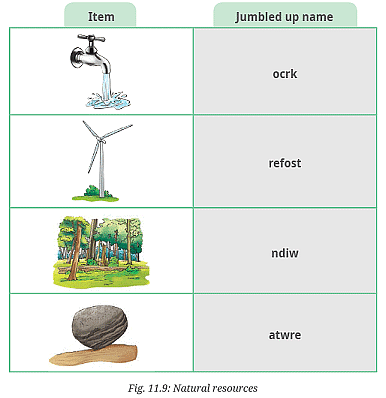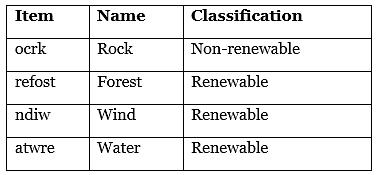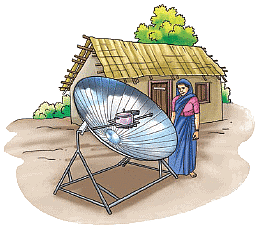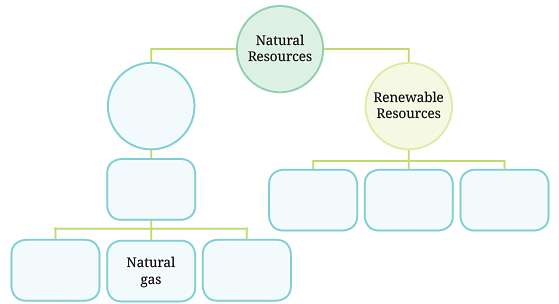Chapter 10 Living Creatures: Exploring their Characteristics Solutions
November 5, 2024Chapter 12 Beyond Earth Solutions
November 5, 2024Chapter 11 Nature’s Treasures Solutions
Text Book Solutions
Let us enhance our learning
Q1: Fig. 11.9 shows items related to natural resources. Match them with their jumbled up names. Make another table and write the names of these resources. Classify these resources as renewable or non-renewable.

Ans: Jumbled up names:
ocrk = Rock
refost = Forest
ndiw = Wind
atwre = Water
Resources:

Q2: State whether the following statements are True [T] or False [F]. If False, correct them.
(i) Nature has all the resources to meet human needs. [ ]
Ans: Nature has all the resources to meet human needs. [T]
(ii) Machines are a resource found in nature. [ ]
Ans: Machines are a resource found in nature. [F]
Correction: Machines are human-made resources, not found in nature.
(iii) Natural gas is a non-renewable resource. [ ]
Ans: Natural gas is a non-renewable resource. [T]
(iv) Air is a renewable resource. [ ]
Ans: Air is a renewable resource. [T]
Q3: Fill in the blanks using the most appropriate option—
(i) A fuel that is commonly used in two wheelers like scooters or bikes is _______
(a) Kerosene
(b) Petrol
(c) Diesel
(d) LPG
Ans: (b) Petrol
(ii) An example of a renewable resource is _______
(a) Coal
(b) Water
(c) Natural gas
(d) Petrol
Ans: (b) Water
Q4: Classify the following as renewable or non-renewable resources—coal, natural gas, forests and minerals.
Ans:
- Coal: Non-renewable
- Natural gas: Non-renewable
- Forests: Renewable
- Minerals: Non-renewable
Q5: Why do we say that petroleum is a non-renewable resource?
Ans: Petroleum is a non-renewable resource because it takes millions of years to form from the remains of microorganisms and plants buried deep inside the earth. Once used, it cannot be replenished within a human lifetime.
Q6: It is difficult to regrow forests. Justify this statement.
Ans: It is difficult to regrow forests because the process of growing trees to maturity takes many years. Additionally, the ecological balance and biodiversity that develop in a forest over centuries cannot be easily replicated. Human activities, such as large-scale deforestation, further complicate the regrowth of forests.
Q7: Make a list of five daily activities in which you use natural resources. Suggest ways by which you can reduce their use.
Ans: Activities and suggestions:
Washing clothes:
Use a washing machine with a full load to save water and electricity.
Taking shower:
Use a water-saving showerhead and take shorter showers.
Cooking:
Use a pressure cooker to save fuel.
Using lights and fans:
Turn off lights and fans when not in use.
Driving a vehicle:
Use public transport or carpool to reduce fuel consumption.
Q8: List four activities that are possible due to the presence of air.
Ans:
Breathing
Flying kites
Inflating balloons
Generating wind energy through windmills
Q9: How can you contribute towards enhancing the green cover of your locality? Make a list of actions to be taken.
Ans:
Actions:
Planting trees and shrubs in the community.
Encouraging community participation in tree-planting drives.
Protecting existing trees from being cut down.
Creating awareness about the importance of green cover.
Supporting local initiatives that aim to increase green spaces.
Q10: In the given illustration, we see that food is being cooked. Answer the following questions:

(i) What type of energy is being used for cooking?
(ii) Name one benefit and one drawback of using this type of energy for cooking.
Ans:
(i) Heat energy (likely from burning fuel or using a stove).
(ii) Benefit: Efficient and quick cooking.
Drawback: Produces smoke and can contribute to indoor air pollution.
Q11: Cutting down trees on a large scale impacts the quality of the soil. Why do you think it is so?
Ans: Cutting down trees on a large scale impacts the quality of the soil because tree roots help in binding the soil, preventing erosion. Without trees, soil becomes loose and can be easily washed away by rain or blown away by wind, leading to loss of fertile topsoil.
Q12: Explain two ways in which human activities pollute the air. Propose one action which can help in reducing air pollution.
Ans:
Ways of pollution:
Emission of pollutants from vehicles.
Industrial emissions releasing harmful gases.
Action to reduce pollution:
Promote the use of electric vehicles and public transportation to reduce emissions from vehicles.
Q13: A family uses solar panels to generate electricity, a gas stove to cook food and a windmill for pumping water from a well. What would happen if there were no sunlight for a week?
Ans: If there were no sunlight for a week, the family would face issues with generating electricity through solar panels, which would affect their power supply. They might need to rely on alternative sources of energy for electricity.
Q14: Fill up the blanks using the following terms— (fossil fuels, forest, air, petroleum, coal, water and non-renewable resource)

Ans:
(i) A fuel that is commonly used in two-wheelers like scooters or bikes is petroleum.
(ii) An example of a renewable resource is water.
(iii) Natural gas is a non-renewable resource.
(iv) Air is a renewable resource.
Q15: There is an increasing demand of trees to meet the requirements of industries and for housing. Therefore, trees are being felled. Is it justified? Discuss and prepare a brief report.
Ans:
Report:
The increasing demand for trees to meet industrial and housing needs is leading to deforestation, which is not justified. Trees are vital for maintaining ecological balance, providing oxygen, and supporting biodiversity. The felling of trees disrupts habitats, contributes to climate change, and leads to soil erosion. Sustainable practices, such as responsible logging, reforestation, and the use of alternative materials, should be adopted to balance development needs with environmental conservation.
Q16: Propose a plan to use less water in your school. What steps would you take to make this plan happen and how would it help the environment?
Ans:
Plan:
Install water-saving fixtures such as low-flow taps and toilets.
Promote awareness among students and staff about the importance of water conservation.
Implement rainwater harvesting systems.
Fix leaks promptly.
Reuse wastewater from handwashing for gardening.
Steps:
Conduct a water audit to identify areas of high-water use.
Educate the school community through workshops and posters.
Collaborate with local authorities or NGOs for technical support in installing water-saving systems.
Regularly monitor and maintain the water systems.
Environmental Benefits: Conserving water reduces the strain on local water resources, ensures sustainable water use, and sets an example for the community. It also helps in reducing the energy used for water treatment and distribution.
Learning Further
Q1: Rainwater harvesting is an age-old practice in India. Find out some of the traditional rainwater harvesting techniques being used in your state or in other parts of the country.
Ans:
Traditional Techniques:
- Rajasthan: Stepwells (Bawadis), tankas (small tanks)
- Gujarat: Vavs (stepwells)
- Maharashtra: Bhandaras (check dams)
- Tamil Nadu: Eri (tanks)
Q2: Investigate the effect of air pollution on human health by interacting with your elders or community members and identify the main sources of air pollution in your local area. Based on your findings, suggest two practical steps that your school or community could take to help reduce air pollution.
Ans:
Effect on Health:
Respiratory problems such as asthma and bronchitis.
Cardiovascular diseases.
Increased risk of lung cancer.
Main Sources:
Vehicle emissions
Industrial emissions
Steps to Reduce Pollution:
Encourage the use of public transportation, cycling, and walking.
Implement stricter regulations for industrial emissions and promote the use of clean technologies.
Prepare a list of the names and uses of important minerals and rocks that are used in your village/town/city for various purposes.
List:
- Granite: Used for construction and countertops.
- Marble: Used for flooring and sculptures.
- Limestone: Used in cement production.
- Sandstone: Used in building materials and paving.
Q3: You are an eco-club monitor. Organize a tree plantation drive in your school with the help of your teacher. List the steps required for organizing this activity. Prepare a one-page report listing the names of the trees planted along with their importance.
Ans: Steps for Tree Plantation Drive:
Plan the event and set a date.
Seek permissions and support from school authorities.
Collaborate with local environmental groups or nurseries for saplings.
Promote the event within the school community.
Organize volunteers and assign roles.
Ensure proper planting techniques.

